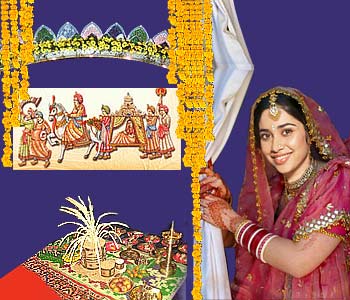Oriya wedding
In keeping with the worship of Lord Jagannath (incarnation of Lord Krishna), Oriya wedding invitation cards are first placed before the diety at the famous temple of Puri. While the Oriya Brahmins hold their weddings in the daytime and preferably in the mornings, other communities conduct the wedding only in the evenings or night.
Once a suitable alliance is found, 'shagun' is given to the groom to stop further search of brides. The girl's family presents some sweets along with money to the boy's side. The girl is gifted with some clothes by the groom's family. The horoscopes are matched to find an auspicious day for the wedding ceremony.
Pre wedding rituals
Jayee Anukolo is the first ritual to be held. Invitation cards are distributed among friends and relatives after the first card is placed before Lord Jagannath. The second card is normally sent to the maternal uncles of the bride and the groom.
Nirbandh is a function similar to the engagement ceremony. The fathers of the bride and the groom take an oath to wed their children to each other.
Jairagodo Anukolo is a ceremony which marks the stoking of the fire. The bride is blessed with the anointed turmeric and bathed in the traditional ritual 'Mangano'. A paste made of turmeric and sandal is applied to the body of the bride.
Oriya wedding
During the Diya Mangala Puja prayers are offered to the deity of a temple. The bridal saree, toe rings and sindoor are placed before the Lord by the barber and the blessings of the Gods invoked for a long and happy married life.
Borojatri or Baraat is the ceremonial procession when the groom and his family members and friends arrive at the wedding mantap amid great pomp and splendor. Upon arrival of the baraat the groom is greeted with aarti/tilak of which rice is an essential component. The bride is decorated with fine traditional jewelry. Oriya brides are seen generally dressed in red, orange or pink outfits for the wedding.
The wedding ritual begins with the Kanyadan ceremony held at the venue specially erected for the wedding. This structure is decorated with lots of flowers and leaves. This is the traditional ritual of handing over the daughter to the groom. The customary fire is lit and the priests chant the mantras. Seven heaps of rice grain symbolizing the seven hills and the saptakulaparwata are worshipped during the saptapadi rite. The couple takes seven rounds around the fire symbolizing the sacred fire as the witness for the marriage.
There is the ritual of Haatho Ghanthi. 'Laja' which is puffed rice, a symbol of prosperity is offered to the fire. The bride's brother stands behind the couple while the couple faces each other. The bride placed her hands on the grooms and her brother puts the puffed rice into them. Together they offer this Laja as an 'ahuti' or sacrifice into the fire amidst the chanting of mantras.
Brides in Orissa are considered as an avatar of Goddess Laxmi bringing abundance of wealth to the new home. Rice is tossed onto the path of the new wed, the new bride tilts a vessel of rice with her feet to spill the grains the threshold of her new home.
Post wedding rituals
The bride now leaves for her new home. Laajo Hom is the consummation of the wedding. The bridal couple arrives at the new home where the groom's family give her a warm ceremonial welcome called Grihapravesh. The bride and the groom are invited to the bride's house on the eighth day after the wedding known as Astha Mangala. Delicious food is prepared and served for the newly married couple.
Bridal attire
The bride in Orissa wears a sari or a lehenga in traditional rich colors like red, orange or magenta. She is bedecked with fine gold jewelry. The bride's mother, female relatives and her friends dress the bride amid much gaiety and joy. The groom wears formal attire which may either be traditional or western.
|

















